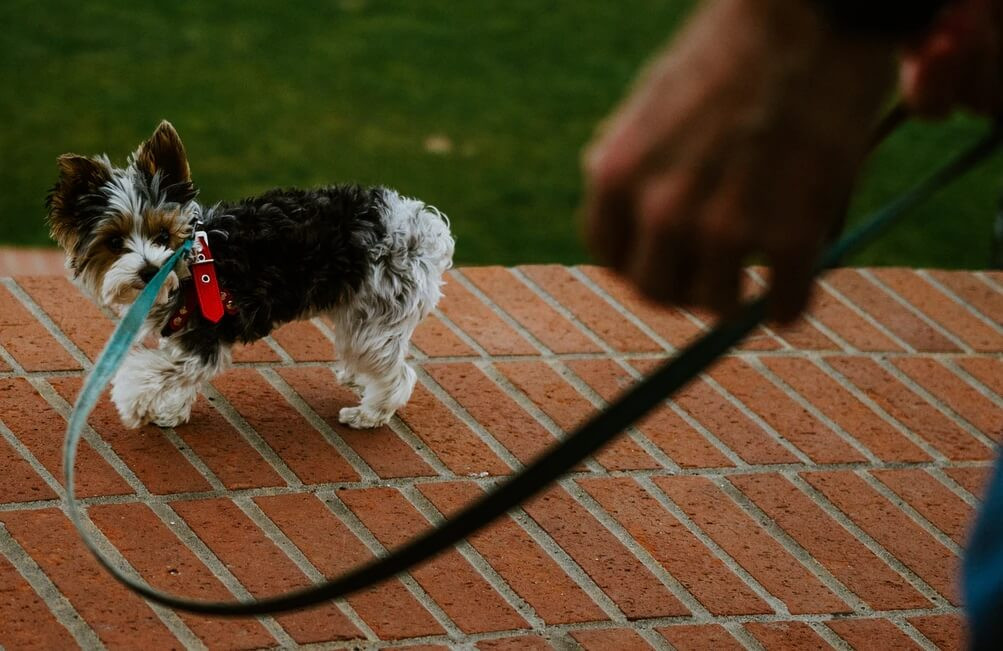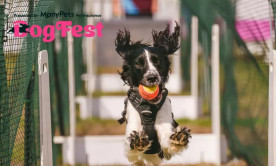Teaching your puppy to walk on a lead is an important behavioural lesson and the sooner they are comfortable on a leash then the easier all training aspects become. Having puppies controlled on lead can be very useful for housebreaking and other training aspects, not just outdoor walks.
You can start to leash train your puppy from ten weeks old.
Why leash training is important for puppies
The sooner your dog learns good behaviours the better. Leash training your puppy will massively reduce the chances of them pulling when they are older and can be more challenging to control.
Puppies are very excitable and the more control you have of them, both in public and in your garden, means you ensure their safety. While they are leash controlled you can easily stop them drinking or eating anything undesirable, helping to prevent illness and injury. You also help keep wildlife safe from your puppy’s (sometimes destructive) curiosity.
It’s is also of course the responsible dog owner thing to do. While on a lead, you are taking responsibility for your puppy and can stop them from getting into mischief while in public.
How to train your puppy to walk on a leash
Collars and harnesses
First you need to teach your puppy to get used to wearing a dog harness or collar as you’ll need to attach a lead to it.
Before you even attempt to put the collar or harness on you need to slowly introduce your puppy to it. Let them sniff it, place treats in it, teach them the sounds of the equipment, and get them generally used to the feel of it. After this you can let them wear it for short periods around a place they feel comfortable.
For more information on introducing your puppy to a harness see our Training Your Dog To Wear A Harness guide.
Basic walking in a controlled environment
Your dog should be completely at ease with wearing a collar or harness and once they’re relaxed, you can attach the leash. Start the training in a controlled environment where your puppy feels safe; this should be done indoors where there are fewer distractions.
Your puppy should associate the leash with a fun experience. So keep the general tone of training playful.
Get your puppy to come to you: Use a sound cue to get your puppy’s attention. This can be a word like “follow” or “come” or you can even use a clicker. Once they look at you after the sound cue, reward them with a treat. Once you’ve repeated this a few times move away from them while holding the leash and repeat the sound cue. Eventually they should start coming over to you.
Continue moving away from the puppy and calling them. They might even follow you unprompted. The important thing is to get them used to being led around on a leash.
Pace around the room with them following on the leash, rewarding and praising them often.
Outdoor walking
Once you have your puppy used to walking on a leash indoors, it’s time to try it outside. This takes more patience as there is more stimulation to get them distracted. This is doubling challenging if you don’t have a garden as the smells will be new and they might get distracted by other dogs.
When walking with them it’s important to try and keep your puppy focused on you. Use your sound cue and continually look back at your dog, this gives them encouragement to follow you. Keep rewarding them with treats to encourage correct actions.
For the first few outings you might want to keep to small area and loop back on yourself to minimize the stimulation.
If you notice your puppy about to become distracted from following you, use your sound cue and move away from the distraction, then reward them with a treat. This helps keeps the dog focused on you and your training and helps prevent them becoming out of control and over stimulated.
Once they are calm and more obedient on a leash in a controlled environment, you can start public walks parks and slowly expand the distance you walk.
Important UK law: Remember that puppies over six weeks old must be microchipped and have visible dog tags when in a public place. For more information read our Dog Tags, Microchipping and the UK Law article.
Pulling
Here at JULIUS K9® UK we’d like to clear one thing up – there is no such thing as a no-pull harness or collar! Pulling is a training issue and not an equipment fix.
However, our official harnesses are designed to distribute weight evenly across the torso, chest, and back which helps minimize the discomfort and injuries which can occur when your dog pulls.
Pulling in leash training
If your puppy pulls in leash training then you should stand firm and still. Refuse to move until they come back to you. You should never yank on the leash to drag your dog back!
Some leash training problems you might see
As we all know, any dog training never goes smoothly. Here are some common problems you might run into:
Leash biting
Puppies like biting things. So your puppy might keep trying to chew on its new leash. If they do, don’t pull the leash directly out of their mouth but instead get their attention with a treat. Like all training, it will take patience and consistency, so whenever they start chewing on the leash in the first few weeks, use the same trick.
Freezing up
If your dog freezes up on you and stops walking that could mean they are nervous or want to go a different way. Keep encouraging them with praise and treats until they start following you again.
Overly hyper
If your puppy is overly excited then it can be difficult to get them to do even the basics without running amok. You should play with them before you start leash training to burn off some of that excess energy. See our guide on Keeping Your Dog Entertained Indoors for some at game ideas you can do at home.
Buying the right equipment – size matters!
Getting good quality gear from brands you trust is always good advice. But one of the most important aspects of buying the right equipment for your puppy is sizing.
You should never buy oversized equipment for your puppy to “grow into”. Harness and collars that are too big are dangerous and can lead to injuries. Even the discomfort of an ill fitting harness makes training more difficult for puppies.
A good dog harness is designed to evenly distribute pressure to across the dog’s chest, tummy and back. So if your puppy pulls on its leash, then this impact is spread across their whole body. If the harness is baggy, then the harness shifts and all pressure is concentrated to one area.
Read our following measuring guides:
Durable gear suitable for puppies
We stock a wide range of leashes ideal for puppies and smaller breeds.
Color&Gray® Super Grip dog leads are popular for owners of younger dogs due to their weather resistance and durability. They also come in range of leash lengths and widths so you can find the ideal one for your puppy.
Our flagship IDC® Powerharness makes a good companion for attaching a leash to. It provides maximum lead control while offering scientifically proven comfort thanks to the even pressure distribution across the dog’s body. There are a wide range of sizes suitable for puppies.











